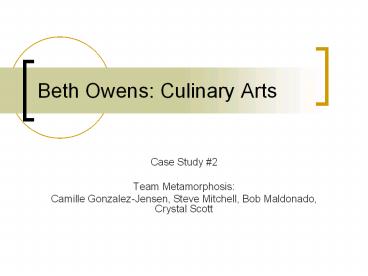Beth%20Owens:%20Culinary%20Arts - PowerPoint PPT Presentation
Title:
Beth%20Owens:%20Culinary%20Arts
Description:
... of Scientific Revolutions, Second edition, Chicago: University of Chicago Press. ... McKenzie, J. (2002, Spring). Questioning as Technology, 12(8) ... – PowerPoint PPT presentation
Number of Views:204
Avg rating:3.0/5.0
Title: Beth%20Owens:%20Culinary%20Arts
1
Beth Owens Culinary Arts
- Case Study 2
- Team Metamorphosis
- Camille Gonzalez-Jensen, Steve Mitchell, Bob
Maldonado, Crystal Scott
2
Introduction
- Theory and Practice
- Textbook knowledge and the everyday concerns of
practice - Field observations that conflict with our Beliefs
- Constructivism and Behaviorism
- Competing Theoretical Frameworks?
- Alternate Menu Items for Design?
3
Beliefs and Bias
- Theory-centered approach to design
- Limits the choices of design strategies
- May rule out legitimate design alternatives
- Pragmatic approach to design
- Greater number of choices for design
- Enables a broader range of instructional solutions
4
Conflict Management
- Key Players
- Beth Owens
- Chef Reiner
- Dean Jacobs
- Beth may be in Conflict
- Chef and Dean Jacobs facing some Problematic
Circumstances
5
Key Players
Strategic approach Outcome of Design Instructional Development Strategy
Beth Owens Theory-Centered Constructivist instruction Using something like the five principles of constructivist instructional design found in Lebow (1993). These principles are provided in the appendix.
Dean Jacobs Needs-based Growth, retention, and quality Employ an Instructional Designer For Program intervention
Chef Reiner Learner-centered Quality and prestige Designing a motivational system that incorporates multi-theoretical frameworks (including a behaviorists approach) to achieve the following outcomes Communicate expectation Encourages student self-regulation based on penalties and rewards Increase Self-discipline and a sense of accomplishment among students.
TABLE 1-1 Key Strategic Instructional Approaches TABLE 1-1 Key Strategic Instructional Approaches TABLE 1-1 Key Strategic Instructional Approaches
6
Conflict Management
- Two approaches
- Scenario 1 Chefs program works Beths beliefs
are conflicted - Scenario 2 Beth must find a way to effectively
verify the success or failure of the dubious
behaviorist approach.
7
Conflict Management
- Solutions
- Scenario 1 No theory is a panacea Beth adopts a
Theory-Neutral approach to Design (Merrill, 2002) - Scenario 2 Quick-fix, Situation-specific,
behaviorist solutions will not lead to a
long-term learning outcome
8
Further Review
- Alumni evaluations
- Current student input
- Former student exit interviews
9
Real World Statistics
- 96 placement rate of graduates
- how many students?
- 60 increase in salary
- dependent on region and type of establishment
10
Evaluation of other models
- Key areas to focus on
- Retention rate
- how many students leave the program?
- Current enrollment
- how much money do these students bring in?
- Areas of study
- how can we keep our current students and attract
new ones?
11
Suggestions for Student Retention
- Chef Reiner teach only upper-level culinary
classes - Introduce some fundamentals at very high level
across 5 areas safety, hygiene, sanitation,
cookery and teamwork - Students choose reputed establishment to
interview, observe and take notes
12
Suggestions for Student Retention
- Students prepare presentation in format of their
choice and deliver in-class - Presentations are not graded - for QA and
feedback only - Marry what students learned with professional
standards - Students model what they learned
- Assessed by instructor, peers, and customers
(comment cards)
13
Suggestions for Student Retention
- For all courses of study, instructor provide only
rudimentary information - Instructor provide problems/activities for
students to work on throughout semester - Some completed individually, others as a group
- Call for the students to go out and explore
- Students present findings to the class
14
Suggestions for Student Retention
- First two (2) problems/activities not graded -
for QA, feedback, collaboration and interaction - Instructor respect what each student has learned
and partner learning with industry expectations - All remaining activities assessed by instructor
and classmates for a grade
15
Suggestions for Student Retention
- Culinary Arts program should partner with local
restaurants, institutional facilities and
caterers - Gain practical, real-life experience
- Help prospective graduates to decide which
business type is most desirable
16
Suggestions for Increasing Enrollment
- Hire person(s) solely responsible for recruitment
- Speak to high school seniors within 150-mile
radius - Do commercial for local TV stations
- Do advertisement for local radio stations
17
Suggestions for Increasing Enrollment
- Prepare and post a Flyer in businesses within
150-mile radius - Conduct Recruitment Fair twice a year
18
Research
- Chang, D. (Posted March 3, 2005) Culinary Schools
enjoy robust enrollment. Miami Herald.com.
Retrieved March 5, 2005. http//www.miami.com/mld/
miamiherald/news/photos/11036416.htm - Johnson Wales University Profile. (n.d.)
Retrieved March 5, 2005. http//www.collegeprofile
s.com/j-wales.html - Kuhn, Thomas S. (1970), The Structure of
Scientific Revolutions, Second edition, Chicago
University of Chicago Press. - Lebow, D. (1993). Constructivist values for
systems design five principles toward a new
mindset. Educational Technology Research and
Development, 41, 4-16. - McKenzie, J. (2002, Spring). Questioning as
Technology, 12(8). Retrieved March 9, 2005, from
http//optin.iserver.net/fromnow/apr03/qtech.html
19
Research (cont.)
- Merrill, M. D. (2002). First principles of
instruction. Retrieved September 9, 2004 from
http//www.indiana.edu/tedfrick/aect2002/firstpri
nciplesbymerrill.pdf - Merrill, M. D., Drake, L., Lacy, M. J., Pratt, J.
A., the ID2 Research Group at Utah State
University (1996). Reclaiming instructional
design. Educational Technology, 36(5), 5-7.
Retrieved September 9, 2004, from
http//www.ittheory.com/reclaim.htm - Reese, S. (vol. 6, 2. April 2004) Culinary Arts
education for a taste of success. Techniques
Magazine,6 ,34-39. Retrieved March 5, 2005.
www.acteonline.org - Shelly, Gary B., Cashman, Thomas J., Rosenblatt,
Harry J. (2003), Systems Analysis and Design,
fifth edition, Course Technology - Wilson, B. G. (2004). Foundations for
Instructional Design Reclaiming the
Conversation. Retrieved September 10, 2004, from
http//carbon.cudenver.edu/bwilson/ReclaimingID.h
tml































